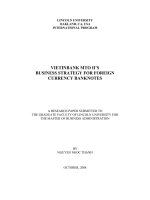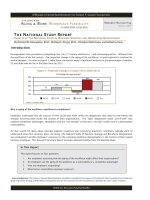Business strategy game simulation CO perfo scored
Bạn đang xem bản rút gọn của tài liệu. Xem và tải ngay bản đầy đủ của tài liệu tại đây (245.61 KB, 8 trang )
Business Strategy Game Simulation
Page 1 of 8
How Company Performance Is Scored
The scoring procedure is tied to how well each BSG company is able to meet or beat the 5 performance targets
which board members have set for the company's management team:
• Grow earnings per share at least 7% annually through Year 15 and at least 5% annually thereafter—The
Board of Directors believes these EPS growth targets are well within reason given that the global footwear
market is expected to grow 7-9% annually through Year 15 and 5-7% annually in Years 16-20. Board
members and shareholders believe a winning strategy should, at a minimum, be able to deliver EPS
growth at the low end of the market growth percentages. All companies had an EPS of $2.50 at the end of
Year 10 (when new management took over).
• Maintain a return on average equity investment (ROE) of 15% or more annually. All companies had a
17.3% ROE in Year 10. Return on average equity is defined as net income divided by the average of total
shareholder equity at the beginning and end of the year. The company’s Balance Sheet reports the change
in equity investment from the beginning of the year to the end of the year and shows the balance sheet
entries where the change in shareholder equity occurred.
• Maintain a B+ or higher credit rating. All companies had a B+ credit rating at the end of Year 10.
• Achieve an “image rating” of 70 or higher. The image rating for each company is based on (1) its branded
Styling/Quality (S/Q) ratings in each geographic region, (2) its market shares for both branded and privatelabel footwear in each of the four geographic regions, and (3) company actions to display corporate
citizenship and conduct operations in a socially responsible manner over the past 4-5 years. All companies
had an image rating of 70 at the end of Year 10.
• Achieve stock price gains averaging about 7% annually through Year 15 and about 5% annually thereafter.
Such stock price gains are within easy reach if the company meets or beats the annual EPS targets and
pays a rising dividend to shareholders. All companies had a stock price of $30 per share at the end of Year
10. Stock price is a function of EPS growth, ROE, credit rating, dividend per share growth, and
management’s ability to consistently deliver good results (as measured by how many of the 5
performance targets are achieved over all completed decision rounds).
The default weights placed on the five performance targets are 20% each. The five weights translate into
20 points out of 100 for each of the 5 performance measures, with the sum of the points adding to a total
of 100 points. There is an option on your Administrative Menu for each “industry” that allows you to alter
these weights however you see fit. The scoring weights selected are reported to all company co-managers in
the narratives at the bottom page 1 of the Footwear Industry Report and also in the narratives showing the
company scores on each scoring variable on pages 2 and 3 of the Footwear Industry Report. Hence, class
members will be well aware of what the weights are.
Using the assigned weights (or corresponding number of points out of 100), each company’s performance on the
5 measures is tracked annually and company performance scores are calculated from two different angles: the
“investor expectations” standard and the “best-in-industry” standard.
Special Note: The scoring procedures described below may seem more complicated than they really are
because we are providing full details and explanations of how the scoring works—in truth a company’s overall
performance cannot be fairly or accurately gauged by “keeping it simple” and looking at just a couple of
performance measures. A “balanced scorecard” for determining how well a company is doing financially and
strategically has to be multi-faceted and somewhat sophisticated in order to look at a company’s performance
from several perspectives and angles.
/>
2/11/2016
Business Strategy Game Simulation
Page 2 of 8
The BSG scoring methodology, introduced in 2004 and now used for thousands of participants, has an
exceptionally good, time-tested track record. The scoring synopsis provided on the scoreboard pages (pages 1,
2, and 3) of the Footwear Industry Report is straightforward and easily grasped—we get few questions about
how the scoring works. Company co-managers can discern exactly why their scores are high or low
relative to the other companies, and it is always indisputably clear which companies are the industry
leaders and which companies are being outperformed.
The Investor Expectations (I.E.) Scoring Standard. The Investor Expectations Standard involves calculating an
annual “Investor Expectation Score” based on a company’s success in meeting or beating the five investorexpected performance targets each year. There is also a Game-to-Date or “all-years” Investor Expectation Score
that shows a company’s success in achieving or exceeding the expected performance targets over all years of the
exercise completed so far. Some important aspects of how the Investor Expectation (I.E.) Scores are calculated
are summarized below:
• Meeting each expected performance target is worth some number of points based on the scoring weight
you select (the default scoring weights—which we recommend using—are 20% or 20-points each). For
instance, if the scoring weight for EPS (or ROE or stock price or image rating or credit rating) is 20%,
meeting the EPS (or ROE or stock price or image rating or credit rating) target earns a score of 20 on the
EPS (or ROE or stock price or image rating or credit rating) performance measure.
• Beating the EPS, ROE, stock price, and/or image rating targets are worth point bonuses of 0.5% for each
1.0% that a company’s actual performance exceeds the expected performance for EPS, ROE, stock price,
and image rating, up to a maximum 20% bonus for each measure. For example, if a company achieves an
EPS of $6.00 when the target is $4.00 and if EPS carries a 20-point weighting, then the company will
receive an EPS score of 24 (because it beat the target by 50% and qualifies for the maximum 20% bonus
over the 20-points awarded for just matching the EPS target). Bonus points are also awarded for credit
ratings above B+, with a full 20% point bonus being given for an A+ rating.
• Failure to achieve the investor-expected target for EPS or ROE or stock price or image rating results in a
score for that performance measure between 0 and the point maximum for that measure, with the score
depending on the percentage of the target achieved. For instance, if a company achieves a stock price of
$20 at a time when the stock price target is $50, then the company’s score on the stock price target
(assuming a 20% weight and thus 20 possible points) would be 8 points (40% of the 20 points awarded for
meeting the stock price target).
• If a company’s EPS is negative, no points are awarded toward meeting investor expectations for EPS.
• If in a given year a company has a negative ROE, no points are awarded on the ROE measure.
• If the point weighting for credit rating is 20 (which equates to a maximum of 24 points including the bonus),
then the various possible credit rating scores are as follows:
A+ 24 points
A 23 points
A- 22 points
B+ 20 points
B 16 points
B- 12 points
C+ 8 points
C 4 points
C- 0 points
• The sum of a company’s scores (including bonus points) on each of the 5 investor-expected targets equals
its annual I.E. Score. Exactly meeting each of the 5 performance targets produces an I.E. Score of 100.
/>
2/11/2016
Business Strategy Game Simulation
Page 3 of 8
Beating the EPS, ROE, stock price, and image rating targets by 20% or more and earning an A+ credit
rating results in a maximum achievable I.E. Score of 120.
• A company’s Game-to-Date Investor Expectation Score is based on (1) its weighted-average EPS for all
years completed versus the average of the EPS targets for all years completed, (2) its weighted-average
ROE for all years completed versus an all-year or ongoing ROE average of 15%, (3) an average of its
image rating for the 3 most recent years as compared to an ongoing, every-year image-rating target of 70,
(4) its most recent year’s stock price versus the most recent year’s stock price target, and (5) its most
recent year’s credit rating versus the ongoing credit rating target of B+, as summarized below:
◦ Game-to-Date I.E. Scoring for EPS is based on how each company’s weighted-average EPS for all
years completed stacks up against the average of the EPS targets for all years completed.
Companies that meet the all-year weighted-average EPS target receive a score equal to the EPS
point weighting; companies that beat the weighted-average EPS target receive bonus points of up to
20%, and companies that fall short of the weighted-average EPS target receive scores equal to the
fraction of the EPS target that was achieved. More details are provided in the Help(?) section for p. 2
of the Footwear Industry Report where game-to-date EPS scores are reported.
◦ Game-to-Date I.E. Scoring for ROE is determined by how each company’s weighted average ROE
for all years completed stacks up against the all-year ROE average target of 15%. Companies that
meet the all-year 15% average ROE target receive a score equal to the ROE point weighting;
companies that beat the 15% ROE target receive bonus points of up to 20%, and companies that fall
short of the 15% target receive scores equal to the fraction of the 15% ROE target that was
achieved. More details are provided in the Help(?) section for p. 2 of the Footwear Industry Report
where game-to-date ROE scores are reported.
◦ Game-to-Date I.E. Scoring for Stock Price hinges only on each company’s most recent year’s stock
price, not some all-year average. The latest stock prices are used to measure the game-to-date I.E.
score for stock price because a company’s latest stock price is a function of EPS growth, ROE,
credit rating, dividend per share growth, and management’s ability to consistently deliver good
results, and thus includes a heavy long-term element. Companies that meet the most recent year’s
stock price target receive a score equal to the stock price point weighting; companies that beat the
most recent year’s stock price target receive bonus points of up to 20%, and companies that fall
short of the most recent year’s stock price target receive scores equal to the fraction of the stock
price target that was achieved. More details are provided on the Help(?) section for p. 2 of the
Footwear Industry Report where game-to-date I.E scores for stock price are reported.
◦ Game-to-Date I.E. Scoring for Credit Rating is keyed to how each company’s most recent credit
rating compares against the ongoing rating of B+. Only the latest year’s credit rating is used to
measure the game-to-date credit rating score, as opposed to an all-year average credit rating,
because a company’s latest credit rating is largely reflective of its long-term financial condition and
the overall balance sheet strength that management has engineered to date. The game-to-date I.E.
scores for credit rating are always the same as for the current-year scores because both are based
on the most recent year’s credit rating. More details about the credit rating scoring are provided on
the Help(?) section for p. 3 of the Footwear Industry Report.
◦ Game-to-Date I.E. Scoring for Image Rating is based on how each company’s average image rating
for the most recent three years stacks up against the al-year average target of 70. A 3-year average
image rating is used to measure game-to-date performance, as opposed to an all-year average, so
as not to burden a company’s performance by image ratings that are not representative of the image
and reputation it has recently achieved with its strategy. Companies whose average image rating for
the most recent 3 years equals the 70 image rating target receive a score equal to the image rating
point weighting; companies with 3-year average image ratings above 70 receive bonus points of up
/>
2/11/2016
Business Strategy Game Simulation
Page 4 of 8
to 20%, and companies with 3-year average image ratings below 70 receive scores equal to the
fraction of the image rating target of 70 that was achieved. More details are provided on the Help(?)
section for p. 3 of the Footwear Industry Report, where the game-to-date image rating scores are
reported.
The sum of a company’s Game-to-Date scores on each of the five scoring measures equals its total Gameto-Date I.E. Score. Special Note: The Game-to-Date I.E. scores are thus definitely not equal to an
average of the annual I.E. scores.
• Both annual and Game-to-Date Scores of 100 to 120 are quite excellent, scores of 90-99 are very good,
scores of 80-89 are good, scores of 70-79 are fair, and scores below 70 reflect consistently “sub-par”
results in meeting the targets that investors expect and that company Board of Directors set for
management to achieve.
The Best-in-Industry (B-I-I) Scoring Standard. The best-in-industry or B-I-I standard concerns how well each
company performs relative to the “best-in industry” performer on 4 measures—EPS, ROE, image rating, and stock
price and how close each company comes to the ultimate credit rating of A+. Again, the performance scores are
based on the weights/points assigned to each of the 5 performance measures, with the sum of the points on the 5
measures adding to 100. The Best-in-Industry Standard entails assigning the best-performing company the
highest number of points and then assigning each remaining company a lesser number of points according to
what percentage of the leader’s performance they were able to achieve. For instance, if ROE is given a weight of
20% (20 points), an industry-leading ROE performance of 25% gets a score of 20 points and a company with an
ROE of 20% (which is 80% as good as the leader’s 25%) gets a score of 16 points (80% of 20 points)—the B-I-I
scores for EPS, stock price and image rating work in precisely the same manner. The procedure is slightly
different for the credit rating measure—each credit rating grade is tied to the number of points your instructor
assigns to the credit rating (an A+ rating always gets a best-in-industry score equal to the instructor-chosen
maximum, with the grades for other credit ratings scaled down all the way to 0 for a C rating).
Each company’s Best-in-Industry (B-I-I) Score is equal to its combined point total on the five performance
measures. In order to receive a score of 100, a company must (1) be the best-in-industry performer on EPS,
ROE, stock price, and image rating, (2) achieve the targets for EPS, ROE, stock price and image rating set by the
company’s Board of Directors, and (3) have an A+ credit rating. B-I-I scores of 80 to 100 reflect good-to-excellent
performance; scores under 50 should cause company co-managers great concern and signal the need for
immediate strategy improvement.
Below are some important aspects of how the Best-in-Industry Scores for a given year are calculated:
• The best-in-industry scoring standard is based on a maximum score of 100 points, with each scoring
variable carrying a 20-point rating (unless you alter the 20% default weights). To get a score of 100, a
company has to be the highest performing company—termed the best-in-industry performer—on all five
performance measures during the year, meet or beat the EPS, ROE, stock price, and image rating targets,
and have an A+ credit rating.
• The best-in-industry performer on each measure earns a perfect score (the full number of points based on
the chosen point weightings—provided the industry leader’s performance on that measure equals or
exceeds the performance target established by company Boards of Directors). Each remaining company
earns a fraction of the points earned by the best-in-industry performer that is equal to its performance (on
EPS, ROE, stock price, and image rating) divided by the performance of the industry-leading company (on
EPS, ROE, stock price, and image rating). For instance, if ROE is given a weight of 20 points, an industryleading ROE performance of 25% gets a score of 20 points and a company with an ROE of 20% (which is
80% as good as the leader’s 25%) gets a score of 16 points (80% of 20 points). Likewise, if EPS is given a
weight of 20 points, an industry-leading EPS performance of $5.00 gets a score of 20 points and a
/>
2/11/2016
Business Strategy Game Simulation
Page 5 of 8
company with an EPS of $2.00 (which is 40% as good as the leader’s $5.00) gets a score of 8 points (40%
of 20 points).
• Whenever the best-in-industry performer’s EPS, ROE, stock price, or image rating is below the
corresponding target for the year, the industry-leading company is not awarded a perfect score (the
maximum number of points) but rather a percentage of the maximum score that equals the leader’s EPS,
ROE, stock price, or image rating as a % of the corresponding target for the year. This is done to prevent a
company with the highest average EPS, ROE, stock price, or image rating from being awarded the
equivalent of an A+ Best-in-Industry Score when its performance on EPS, ROE, stock price or image rating
actually falls short of the level established by company Boards of Directors. In all such instances, each
remaining company will earn a fraction of the points earned by the best-in-industry performer, with that
fraction being equal to its performance (on EPS, ROE, stock price, and image rating) divided by the
performance of the industry-leading company (on EPS, ROE, stock price, and image rating).
• The procedure for assigning best-in-industry scores is a bit different for the credit rating measure. Each
credit rating grade from A+ to C carries a certain number of points that scales down from the maximum
number of points for an A+ credit rating to 1point for a C rating. If the credit rating weight is 20 points out
of 100, the B-I-I point awards for credit rating are as follows:
A+ 20 points (or 100% of the point weighting)
A 19 points (or 95% of the point weighting)
A- 18 points (or 90% of the point weighting)
B+ 17 points (or 85% of the point weighting)
B 14 points (or 70% of the point weighting)
B- 11 points (or 55% of the point weighting)
C+ 8 points (or 40% of the point weighting)
C 4 points (or 20% of the point weighting)
C- 1 point (or 5% of the point weighting)
• All companies that lose money in any given year and end up with a negative EPS automatically receive a
best-in-industry EPS score of 0 points.
• Similarly, companies with a negative ROE have a best-in-industry ROE score of 0 points.
• Each company’s B-I-I score equals its combined point total on the five performance measures.
• Best-in-Industry performance scores of 90-99 are excellent, scores of 80-89 are good to very good, scores
of 70-79 are fair to good, scores of 60-69 are weak to fair, and scores below 60 reflect a performance
roughly 40% or more below that of companies with scores in the 90s—which says that such companies
were outperformed by other companies in the industry by a significant margin.
The highest possible Best-in-Industry (B-I-I) Score is 100, earned only if a company is the best performer on EPS
(with an EPS equal to or above the target), the best performer on ROE (with an ROE of at least 15%), the best
performer on stock price (with a stock price equal to or above the yearly target), and the best performer on image
rating (with an image rating of at least 70) and also has an A+ credit rating.
Combining the Annual and Game-to-Date I.E. Scores and B-I-I Scores into Overall Scores. The scoring includes
both an annual and a game to date “Overall Score” for each company. These scores are determined by
combining each company’s Investor Expectation Score and the Best-in-Industry Score into a single score using
whatever weighting you wish (the default weighting—which we strongly recommend—is 50-50). The Annual
Overall Scores for the various companies are a weighted average of their respective annual I.E. scores and the
annual B-I-I scores, while the Game-to-Date Overall Scores are a weighted average of the game-to-date I.E.
scores and the game-to-date B-I-I scores.
/>
2/11/2016
Business Strategy Game Simulation
Page 6 of 8
Since I.E. scores can range as high as 120, it is common for the Overall Scores of the very best-performing
companies to be greater than 100. Overall Scores greater than 100 are clearly indicative of superior company
performance and are definitely worthy of an A or A+. As a general rule, we think that companies with an overall
performance score of 90 or above at the conclusion of the decision rounds should get anywhere from an A– to an
A+ on this portion of the BSG exercise. Companies with overall game-to-date scores of 80-89 should get a B– to
a B+ (or higher if there are no companies with scores of 90 or more). Companies with an overall performance
score of 70-79 above should get a grade in the C range (or higher depending on how many companies have
higher scores). You may find it desirable to scale the company grades if competition turns out to be so fierce or
cutthroat that companies in the industry can’t earn profits that meet investors’ performance expectations and thus
end up with “low” overall game-to-date scores. In most of our classes, we end up scaling the performance scores
of companies with overall scores below 70, but there is usually at least one company with a score above 90
(clearly meriting an A)—hence scaling the grades on the upper end of the industry rankings is typically
unnecessary.
The latest Game-to-Date I.E. scores, Game-to-Date B-I-I scores, Game-to-Date Overall Scores, and industry
rankings (based on the Overall Scores) are shown on the same page as the Administration Menu for each
“industry” you have created for your class or classes. A Scoreboard Box containing the same information is
always prominently displayed on each company’s Corporate Lobby page (the first screen they see when they log
on at www.bsg-online.com). Moreover, after each decision round, all company co-managers can view or print a
complete Company Scoreboard showing each company’s performance on every aspect of the scoring, including
all the scoring weights. The Help sections for each page of the 3-page Company Scoreboard provide detailed,
easy-to-understand explanations of the scoring so company co-managers should encounter no “mystery” factor
about how the scoring works or where each company stands in the industry performance rankings.
Bonus Point Scoring Awards. Every decision round, companies have the opportunity to qualify for two special
bonus point awards that can boost their company’s overall game-to-date score. Both bonus awards are a part of
the simulation scoreboard, are calculated and awarded automatically to qualifying companies, and shown as an
addition or adjustment to a company’s overall score. Here’s what the two bonus point awards involve:
• Bull’s Eye Award (awarded annually for accurately projecting company performance) — One bonus point
is added to a company’s game-to-date score when (1) the company’s actual total revenues are within ±5%
of projected total revenues, (2) the company’s actual EPS is within 10¢ or ±5% of projected EPS, and (3)
the company’s actual image rating is within ±4 points of the projected image rating. To qualify for the
Bull’s Eye Award in a given year a company must achieve all three of the above requirements for
that year.
◦ Standard rounding rules apply to the &plusmin;5% calculations for revenues and EPS. There
are no decimal points involved in the calculation and reporting of a company’s Image Rating.
◦ No partial bonus points are awarded when just one or two of these three conditions are met.
◦ There are as many 1-point Bulls Eye bonus point awards as there are companies that meet all
three conditions.
◦ There is no limit on the number of Bull’s Eye Awards a given company can receive. Hence
receiving a Bulls Eye Award for each of the various decision rounds can significantly impact a
company’s overall score
◦ While Bull’s Eye Award statistics are provided during the practice rounds for illustrative purposes,
any awards are erased after the practice rounds—in other words, any Bull Eye Awards during the
practice rounds “do not count” and will not be included in the bonus-point additions to a company’s
final game-to-date score.
/>
2/11/2016
Business Strategy Game Simulation
Page 7 of 8
◦ The total bonus points accumulated by each company and the bonus-point-adjusted overall score
for each company are shown in the bottom section of page 1 of the Footwear Industry Report where
the Overall Game-to-Date company scores appear.
• Leap Frog Award (awarded annually for most improved overall current-year performance score) ‐
Beginning in Year 12, one bonus point is added to a company’s overall game-to-date score when the
company’s current-year score shows the biggest improvement over its current score for the prior year
(based on number of points, rather than percentage improvement) in comparison to the score gains of all
other companies in the industry.
◦ The first Leap Frog Award is given in Year 12 (since it takes two years of results for a company to
show improvement over its prior year’s results).
◦ In case two or more companies tie for the biggest point-improvement in overall score, each
company will receive a 1-point Leapfrog Award bonus.
◦ In the rare instance where all companies fail to improve their current scores from one year to
the next (indicated by a negative year-to-year change in overall score for all companies in the
industry), a Leap Frog bonus is not awarded.
◦ The total bonus points accumulated by each company and the bonus-point-adjusted overall score
(including both Bull’s Eye and Leap Frog bonuses) for each company are shown in the bottom
section of page 1 of the Footwear Industry Report where the Overall Game-to-Date company scores
appear.
The Bull’s Eye and Leap Frog awards accomplish three worthwhile purposes:
1. Provide an additional element of interest and excitement for students/participants when the performance
outcomes are generated as the deadline for each decision-making round passes.
2. Spur company co-managers to put more thought and analysis into making accurate projections of
upcoming-year outcomes and searching for a strategy and decision combination with the most realistic
chance of producing good year-over-year overall improvement (just as occurs in real-world companies).
Students will certainly appreciate being rewarded when their efforts to accurately anticipate their
company’s performance or to achieve a bigger jump in overall score than rival companies are successful.
3. Give company-teams an opportunity to enhance their overall score via measures outside the five standard
simulation scoring variables (EPS, ROE, Stock Price, Credit Rating, and Image Rating). This may serve as
an additional incentive for companies not currently challenging for the industry lead.
There’s a page in the Footwear Industry Report (page 3b) devoted exclusively to reporting the bonus points
awarded to all companies across all the decision rounds—the accompanying Help pages provide students with
detailed explanations of how the Bonus Point awards are calculated. Since the total bonus points accumulated by
each company and the bonus-point-adjusted overall score for each company are shown on page 1 of the
Footwear Industry Report, all class members and the Instructor can readily track the status and impact of the
bonus point awards throughout the simulation exercise.
By default, the Bonus Point Scoring Awards are enabled when you complete the Course Setup procedure
and set up the simulation exercise for your class. However, if you wish, you can disable the awarding of
bonus points by unchecking the Bonus Awards box that appears in the Company Performance Grade
Book (which is accessed from your Administration Menu). We strongly urge that you utilize the bonus
point scoring feature at least initially—even if you are skeptical about its value. We are quite confident
that your class members will enthusiastically applaud its use and that you will come to see the merits of
the bonus point awards.
/>
2/11/2016
Business Strategy Game Simulation
Page 8 of 8
What to Do If You Decide to Alter the Default Scoring Weights. The “default weights” for the five performance
measures on which each company is scored were set at 20% each because a 20% weight for each of the five
variables constitutes a “balanced scorecard” that is in reasonably close accord with judging the performance of
real-world companies. However, you can alter these weights any time you see fit, using item F on the
Administration Menu—the details are presented in the following section.
What to Do If You Want to Change the 50-50 Default Weights for the Two Scoring Standards. As explained
above, the default weights for the 2 scoring standards in The Business Strategy Game are 50% for the Investor
Expectations Standard and 50% for the Best-in-Industry Standard. Other alternatives include 67%-33%, 33%
-67%, 75%-25%, 25%-75%, 80%-20%, or 20%-80%. Of course, if you want to use just one of the standards, you
can place a weight of 100% on that standard and a 0% weight on the other.
To select weights other than 50-50, you will need to go to the online grade book (item C on the Administrative
Menu), click on the Company Grade Book link, enter the desired weights for the 2 scoring standards in the boxes
near the top of the grade book, and press the “Save” button—the weighted average performance scores in the
right column of the grade book will automatically be recalculated and the Overall Scores in the Scoreboard box on
your Industry Menu page and on each company’s Corporate Lobby page will be based on the new weights.
Concluding Comments about Scoring Company Performance. One very important point about the BSG scoring
methodology warrants emphasis: it is a company’s overall score that matters (how close company scores are
to 100-120 in the case of the Investor Expectations Standard and how close they are to 100 in the case of the
Best-in-Industry Standard), not whether a company is in first or last place. There will always be a last place
company, but what is truly telling is whether it is in last place with a score of 85 (which clearly signals a
strong performance and a deservedly good grade) or in last place with a score of 37 (which clearly
signals a poor performance and possibly a lower grade).
/>
2/11/2016









